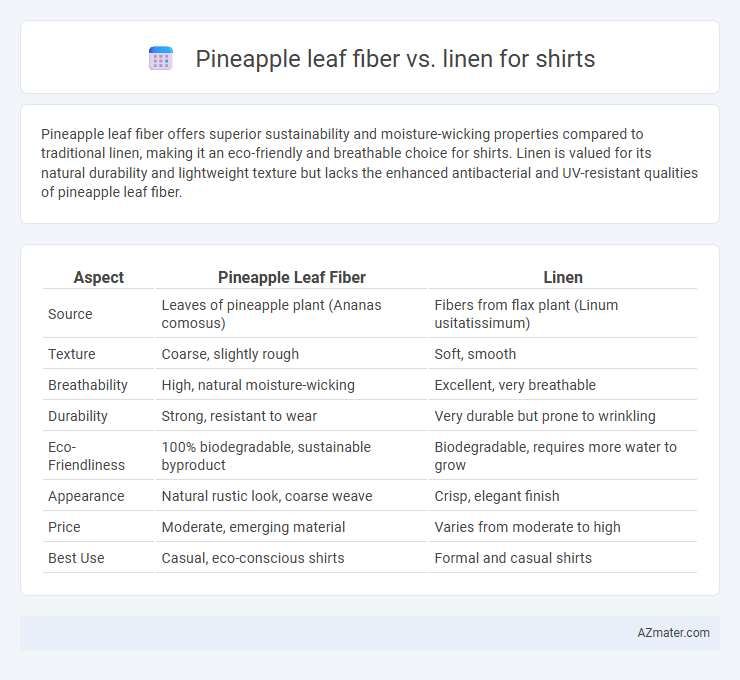Pineapple leaf fiber offers superior sustainability and moisture-wicking properties compared to traditional linen, making it an eco-friendly and breathable choice for shirts. Linen is valued for its natural durability and lightweight texture but lacks the enhanced antibacterial and UV-resistant qualities of pineapple leaf fiber.
Table of Comparison
| Aspect | Pineapple Leaf Fiber | Linen |
|---|---|---|
| Source | Leaves of pineapple plant (Ananas comosus) | Fibers from flax plant (Linum usitatissimum) |
| Texture | Coarse, slightly rough | Soft, smooth |
| Breathability | High, natural moisture-wicking | Excellent, very breathable |
| Durability | Strong, resistant to wear | Very durable but prone to wrinkling |
| Eco-Friendliness | 100% biodegradable, sustainable byproduct | Biodegradable, requires more water to grow |
| Appearance | Natural rustic look, coarse weave | Crisp, elegant finish |
| Price | Moderate, emerging material | Varies from moderate to high |
| Best Use | Casual, eco-conscious shirts | Formal and casual shirts |
Introduction to Pineapple Leaf Fiber and Linen
Pineapple leaf fiber, derived from the leaves of the pineapple plant, is a sustainable, biodegradable textile known for its high tensile strength and natural sheen, making it an innovative choice for eco-friendly shirts. Linen, made from the flax plant, is a traditional fabric prized for its breathability, durability, and moisture-wicking properties, ideal for lightweight, comfortable shirts. Both fibers offer distinct benefits, with pineapple leaf fiber emphasizing sustainability and texture, while linen highlights classic comfort and timeless appeal.
Origins and Production Processes
Pineapple leaf fiber is derived from the leaves of the pineapple plant, primarily cultivated in the Philippines and parts of Southeast Asia, where leaves are extracted, dried, and mechanically processed into fine fibers. Linen, made from the flax plant grown in regions like Europe and Russia, undergoes retting, drying, and scutching to separate fibers from stalks before spinning. Both fibers are natural and sustainable, but pineapple leaf fiber production emphasizes agricultural waste utilization, while linen production relies on traditional flax cultivation and labor-intensive fiber extraction methods.
Environmental Impact Comparison
Pineapple leaf fiber, derived from the waste of pineapple plants, offers a sustainable alternative to traditional linen by utilizing agricultural byproducts and reducing resource consumption. Linen, made from flax plants, requires significant water and pesticide inputs during cultivation, leading to greater environmental strain compared to pineapple leaf fiber, which thrives with minimal irrigation and chemicals. Both fibers are biodegradable and renewable, but pineapple leaf fiber's low-impact farming practices and waste repurposing significantly lower its ecological footprint in shirt production.
Fiber Properties and Texture
Pineapple leaf fiber is known for its strength, breathability, and slight coarseness, providing a textured feel that softens with wear and washing. Linen, made from flax fibers, offers a smooth, lightweight texture with excellent moisture-wicking properties and superior durability. Both fibers are natural and breathable, but pineapple leaf fiber tends to have a rougher texture initially compared to the inherently softer and drapier linen fabric.
Breathability and Comfort
Pineapple leaf fiber offers superior breathability compared to linen due to its natural porous structure, allowing better air circulation and moisture absorption. The fiber's lightweight and softness enhance comfort, making shirts more comfortable for extended wear in warm climates. While linen is also breathable and durable, pineapple leaf fiber provides a more sustainable and eco-friendly alternative without compromising comfort.
Durability and Longevity
Pineapple leaf fiber offers exceptional durability due to its high tensile strength and natural resistance to wear, making it ideal for long-lasting shirts. Linen, derived from the flax plant, also boasts strong fibers but can be prone to fraying and weakening after extensive washing over time. Both materials provide breathable comfort, yet pineapple leaf fiber maintains its integrity longer, ensuring greater longevity in everyday garment use.
Moisture Absorption Capabilities
Pineapple leaf fiber exhibits superior moisture absorption capabilities compared to linen, effectively wicking sweat away from the skin, which makes it ideal for hot and humid climates. The natural hydrophilic properties of pineapple leaf fiber enhance breathability and quick drying, improving wearer comfort during physical activity. In contrast, linen, while breathable, tends to retain moisture longer, which can lead to a clammy feel in high humidity environments.
Aesthetic Appeal and Fashion Trends
Pineapple leaf fiber offers a unique, natural texture with a subtle sheen that enhances the aesthetic appeal of shirts, aligning with sustainable fashion trends. Linen provides a classic, breathable fabric with a crisp drape, favored for its timeless elegance and versatility in both casual and formal styles. Fashion trends increasingly favor pineapple leaf fiber for eco-conscious consumers seeking innovative, stylish alternatives to traditional fabrics like linen.
Cost and Market Availability
Pineapple leaf fiber shirts typically cost 15-30% less than linen due to lower raw material expenses and simpler processing techniques. Linen has a more established global market presence with widespread availability in fashion and textile industries, whereas pineapple leaf fiber remains niche but growing, primarily sourced from Southeast Asia. Market availability of pineapple leaf fiber shirts is limited compared to linen, impacting mass production and accessibility in mainstream retail.
Final Verdict: Which Is Better for Shirts?
Pineapple leaf fiber offers superior sustainability and a unique texture compared to linen, making it an eco-friendly choice for shirts with natural breathability and moisture-wicking properties. Linen, known for its durability, crisp feel, and timeless elegance, excels in comfort and long-lasting wear due to its strong flax fibers. For shirts, linen remains the optimal choice owing to its proven performance and classic appeal, while pineapple leaf fiber presents an innovative alternative for environmentally conscious consumers seeking novelty in fabric.

Infographic: Pineapple leaf fiber vs Linen for Shirt
 azmater.com
azmater.com